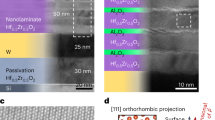Abstract
Loading a two-dimensional grid with active devices offers a means of combining the power of solid-state oscillators in the microwave and millimeter-wave range. The grid structure allows a large number of negative resistance devices to be combined. This approach is attractive because the active devices do not require an external locking signal, and the combining is done in free space. In addition, the loaded grid is a planar structure amenable to monolithic integration. Measurements on a 25-MESFET grid at 9.7 GHz show power-combining and frequencylocking without an external locking signal, with an ERP of 37 W. Experimental far-field patterns agree with theoretical results obtained using reciprocity.
Similar content being viewed by others
References
V. P. Kesan, D. P. Neikirk, T. D. Linton, P. A. Blakey, B. G. Streetman, “Influence of the Transit Time Effects on the Optimum Design and Maximum Oscillation Frequency of Quantum Well Oscillators,”12th International Conference on Infrared and Millimeter Waves, Orlando, Florida, December 1987.
L. Wandinger, V. Nalbandian, “Millimeter-Wave Power Combiner Using Quasi-Optical Techniques,”IEEE Transactions on Microwave Theory and Techniques, Vol. MTT-31, No. 2, pp. 189–193, February 1983.
J. W. Mink, “Quasi-Optical Power Combining of Solid-State Millimeter-Wave Sources,”IEEE Transactions on Microwave Theory and Techniques, Vol. MTT-34, pp. 273–279, February 1986.
K. D. Stephan, “Inter-Injection-Locked Oscillators for Power Combining and Phased Arrays,”IEEE Transactions on Microwave Theory and Techniques, Vol. MTT-34, pp. 1017–1025, October 1986.
K. Mizuno, T. Ajikata, M. Hieda, and N. Nakayama, “Quasi-Optical Resonator for Millimeter and Submillimeter Wave Solid-state Sources,” submitted for publication toElectronics Letters.
W. W. Lam, C. F. Jou, H. Z. Chen, K. S. Stolt, N. S. Luhmann, D. B. Rutledge, “Millimeter-Wave Diode-Grid Phase-Shifters,” To be published in theIEEE Transactions on Microwave Theory and Techniques.
C. F. Jou, W. W. Lam, H. Z. Chen, K. S. Stolt, N. C. Luhmann, D. B. Rutledge, “Millimeter-Wave Diode-Grid Frequency Doubler,” To be published in theIEEE Transactions on Microwave Theory and Techniques.
Z. B. Popović, D. B. Rutledge, “Diode-Grid Oscillators”,1988 IEEE Antennas and Propagation Symposium, Syracuse, New York, June 1988.
H. Y. Yang, N. G. Alexópoulos, “Gain Enhancement Methods for Printed Circuit Antennas Through Multiple Superstrates”,IEEE Transactions on Antennas and Propagation, vol. 35, No. 7, July 1987.
Author information
Authors and Affiliations
Rights and permissions
About this article
Cite this article
Popović, Z.B., Kim, M. & Rutledge, D.B. Grid oscillators. Int J Infrared Milli Waves 9, 1003–1010 (1988). https://doi.org/10.1007/BF01010771
Received:
Issue Date:
DOI: https://doi.org/10.1007/BF01010771




